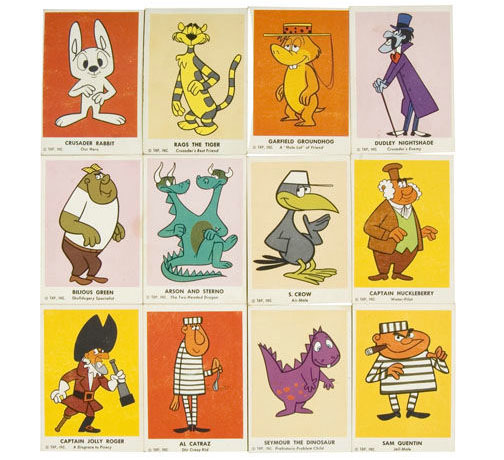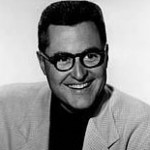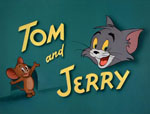Missing Comic Strip Treasure. I love comic strips, especially those featuring animated characters. I hope with this flood of books reprinting strips that someone arranges to have the Bullwinkle strips by Al Kilgore (sample below) compiled into a book. Of course, some comic strips are only known these days by word-of-mouth or just remain unpublished samples (like ones from the 1960s with Pink Panther and Beany and Cecil) locked away in private collections.

In 1959, Jack Miller who had worked on storyboards for the TV Spots version of Crusader Rabbit claimed that he had drawn at least thirty-five daily newspaper strips featuring the characters from that series. They were actually done as disguised advertising for the series sponsor, Bell Brand Potato Chips. Each strip was supposedly three to five panels and were a daily gag, not a continuing story that had to be run in a particular order and each featured as reference to Bell Brand. Over a year after he first drew them, Miller continued to receive a regular but small royalty check and then they stopped coming. Famed comic historian Bill Blackbeard was unable to locate any samples.
Bell Brand Potato Chips did give-away these Crusader Rabbit character cards (below) in tie-in packages of their product:

The Whoopi Goldberg Animated Series That Never Was. In 1988, celebrity Whoopi Goldberg told the Hollywood Reporter trade paper that “I’m thrilled at the prospect of working with Hanna-Barbera. They are and have been the premiere creative force in the world of animation. This is a new area for me, so I couldn’t be happier about having the opportunity to work with the best. I have a lot to say to our younger generation and this is a great way to reach out and entertain.”
Planned was a Saturday morning TV series that would feature Goldberg in live-action wraparounds at the beginning and close of each episode. The animated portion would feature new characters developed by the actress who would have provided voices for several of them.
Senior vice president of H-B programming said, “Goldberg is involved totally in every aspect from artwork, concept and types of stories she wants to tell. She wants to develop a children’s program that is totally different than what is normally seen on Saturday mornings. The series will address the realistic problems that kids today face from Whoopi’s point of view and with her special humor. One such topic will be dyslexia, a condition that Whoopi has. That kind of topic will be addressed from a kid’s point of view.”
In addition, Goldberg was working with producer Joe Barbera on developing animated primetime specials.
 The Animation Heritage of Disney. From the Boston Ledger newspaper Jan. 30-Feb 5, 1988, Jeffrey Katzenberg, then Chairman of the motion picture and television division of the Disney Company, said, “(Disney) is not forgetting our heritage and we’re not forgetting a franchise which no one else in the world has. I don’t believe every movie we make must appeal to all segments of the audience. And Disney animated product is primarily made for the two to fourteen year old audience. It’s not made for teenagers. It’s not made for college kids. It’s made for families. It is made for parents to be able to take their children.
The Animation Heritage of Disney. From the Boston Ledger newspaper Jan. 30-Feb 5, 1988, Jeffrey Katzenberg, then Chairman of the motion picture and television division of the Disney Company, said, “(Disney) is not forgetting our heritage and we’re not forgetting a franchise which no one else in the world has. I don’t believe every movie we make must appeal to all segments of the audience. And Disney animated product is primarily made for the two to fourteen year old audience. It’s not made for teenagers. It’s not made for college kids. It’s made for families. It is made for parents to be able to take their children.
“And we don’t consider that a bad thing. We don’t consider that a limited thing. Do we believe that an animated film is going to go out and find the level of success of a Ghostbusters or a Star Wars? No. That’s not the business we’re in. It’s a profitable business for us. But I tell you, if it were only a break-even business for us, we would still do it. It is the foundation of our company. It is the heritage of our company and it is something that we are absolutely committed to.”
 Jones’ Favorite Characters. Chuck Jones, interviewed in Business Screen magazine (Aug/Sept 1982) said, “Pepe Le Pew and Bugs Bunny are naturally characters I’d like to be. They have the appeal of absolute certainty. They’re able to handle a situation and I wish I could always do that. But I also recognize the Coyote because like him, I have an absolute failure with tools. I can understand his problem. The Roadrunner never does anything to him except say ‘Beep, beep’. And so all the failures are his own. A character I really didn’t understand but I love him is the singing frog in One Froggy Evening. But he’s not a favorite as such.”
Jones’ Favorite Characters. Chuck Jones, interviewed in Business Screen magazine (Aug/Sept 1982) said, “Pepe Le Pew and Bugs Bunny are naturally characters I’d like to be. They have the appeal of absolute certainty. They’re able to handle a situation and I wish I could always do that. But I also recognize the Coyote because like him, I have an absolute failure with tools. I can understand his problem. The Roadrunner never does anything to him except say ‘Beep, beep’. And so all the failures are his own. A character I really didn’t understand but I love him is the singing frog in One Froggy Evening. But he’s not a favorite as such.”
 Clampett Speaks. Animator and director Bob Clampett being interviewed by Walt Trott for the Capital Times Chicago newspaper in 1978 said, “The first thing I remember seeing as a kid was those (Sunday newspaper) colored funny papers. Then I started making drawings of characters like Jiggs and Maggie. I utilized toilet paper and would write out a story for them – the paper was much thicker then. I’d draw each frame and when I got to the last of the paper, I’d come up with an ‘end’ joke. Silent (animated) cartoons were not so interesting but when the character moved to the music and said something it became exciting.”
Clampett Speaks. Animator and director Bob Clampett being interviewed by Walt Trott for the Capital Times Chicago newspaper in 1978 said, “The first thing I remember seeing as a kid was those (Sunday newspaper) colored funny papers. Then I started making drawings of characters like Jiggs and Maggie. I utilized toilet paper and would write out a story for them – the paper was much thicker then. I’d draw each frame and when I got to the last of the paper, I’d come up with an ‘end’ joke. Silent (animated) cartoons were not so interesting but when the character moved to the music and said something it became exciting.”
 Zemeckis Directing Animation. From Los Angeles Times Calendar section June 22, 1998, director Robert Zemeckis of Who Framed Roger Rabbit got involved with giving directions to the animators as well. “I gave them directions the same way I would an actor in rehearsal,” said Zemeckis. “I worked with the performances. Make this sadder or happier or broader. Very often, they’d sketch a pose I struck as a I explained what I wanted, then we’d refine that further.”
Zemeckis Directing Animation. From Los Angeles Times Calendar section June 22, 1998, director Robert Zemeckis of Who Framed Roger Rabbit got involved with giving directions to the animators as well. “I gave them directions the same way I would an actor in rehearsal,” said Zemeckis. “I worked with the performances. Make this sadder or happier or broader. Very often, they’d sketch a pose I struck as a I explained what I wanted, then we’d refine that further.”
Tom Sito who animated the scene where Judge Doom’s weasel henchmen laugh themselves to death said, “Even when his evaluation of your work was tough, it was always intelligent and fair. Instead of fussing about details in your drawings, he focued on what the audience would get out of the scene. When you finished talking with him, you knew your work was stronger and more effective.”
 The Difference in Russian Animation. In a follow-up to the anecdote I posted last week, Soviet animation director Fyodor Khitruk told the Los Angeles Times November 17, 1987 “Russian and American audience are very different. The reaction to the program of Soviet films I showed in Minneapolis last week was more enthusiastic than any in the Soviet Union. There, I could only dream of such an audience! But when people here (in the United States) see animation, they expect something funny. They wait for the moment when they can laugh. If the film has no real gags, they’ll laugh at anything that resembles one. They’re not used to serious animated films. You’ve trained people to expect jokes. I think Tom and Jerry and Road Runner cartoons are very important, but it’s just as important to have some serious work being done. There should be a balance.”
The Difference in Russian Animation. In a follow-up to the anecdote I posted last week, Soviet animation director Fyodor Khitruk told the Los Angeles Times November 17, 1987 “Russian and American audience are very different. The reaction to the program of Soviet films I showed in Minneapolis last week was more enthusiastic than any in the Soviet Union. There, I could only dream of such an audience! But when people here (in the United States) see animation, they expect something funny. They wait for the moment when they can laugh. If the film has no real gags, they’ll laugh at anything that resembles one. They’re not used to serious animated films. You’ve trained people to expect jokes. I think Tom and Jerry and Road Runner cartoons are very important, but it’s just as important to have some serious work being done. There should be a balance.”



 Jim Korkis is an internationally respected animation historian who in recent years has devoted his attention to the many worlds of Disney. He was a columnist for a variety of animation magazines. With his former writing partner, John Cawley, he authored several animation related books including The Encyclopedia of Cartoon Superstars, How to Create Animation, Cartoon Confidential and Get Animated’s Animation Art Buyer’s Guide. He taught animation classes at the Disney Institute in Florida as well as instructing classes on acting and animation history for Disney Feature Animation: Florida.
Jim Korkis is an internationally respected animation historian who in recent years has devoted his attention to the many worlds of Disney. He was a columnist for a variety of animation magazines. With his former writing partner, John Cawley, he authored several animation related books including The Encyclopedia of Cartoon Superstars, How to Create Animation, Cartoon Confidential and Get Animated’s Animation Art Buyer’s Guide. He taught animation classes at the Disney Institute in Florida as well as instructing classes on acting and animation history for Disney Feature Animation: Florida.




















































On Soviet (now Russian) animation. I recall that there was a television station in Mexico City XEIPN-TV (IPN is well known University in Mexico City “El Instituto Politécnico Natcional” or National Polytechnic Institute in English). They once had a program called Ventajas de Colores (Colorful Windows) which showcased animated cartoons from the World. In the first few years they shown animated shorts from the USSR/Russia from family friendly shorts to propaganda cartoons (yes propaganda cartoons) to dark cartoons that weren’t suitable for children..(but usually those cartoons were shown late at night).
There were “one shot shorts” that were shown and also Series of shorts were shown too like Oh Those Monkeys, about a mischievous family of young monkeys who escaped from the local zoo and their por mother trying in vain to get them back safely to their home in the zoo.
Some of my favorite animated shorts from USSR/Russia are…
• The Messenger Fish about a litte girl living in a farming commune asking the postman why her sister Valentina wasn’t getting letters from her boyfriend (who was serving in the Red Navy of the USSR in a submarine battalion) and getting her pet fish deliver the letter for her sister.
• Thumbelina, a beautiful animated short.
• A Fantasia like animated cartoon featuring the music of Tchaikovsky set during Czarist Russia.
• A weird animated short about a retired general from the Red Army training and commanding a Army of cockroaches
• And The Nutcracker animated by Soyuzmultfilm which became a international favorite during the holiday season.
Here are a few surviving examples of the Crusader Rabbit comic strips / ads.
http://www.theimaginaryworld.com/bell32.jpg
http://www.theimaginaryworld.com/bell33.jpg
http://www.theimaginaryworld.com/bell34.jpg